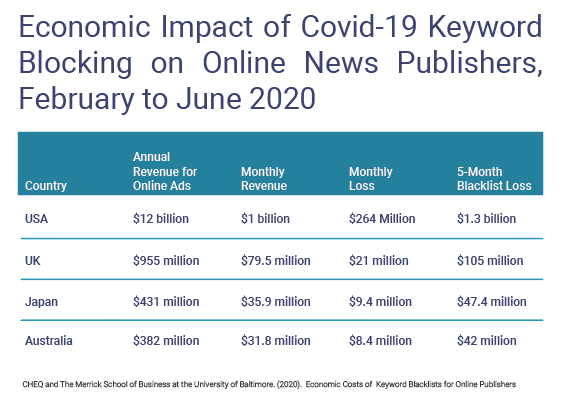Over the last couple of years, the ad tech industry has faced numerous assaults on its business paradigm which has failed to strike a balance between protection and reach. First there was the development of GDPR, followed by numerous other regulatory requirements and privacy laws around the globe. Then, earlier this year, Google announced it would be dropping third-party cookies within the next couple of years. As the Ad Tech industry scrambled to understand what this would mean to the future of ad platforms and programmatic advertising, the global economy was — and continues to be — crippled by the Coronavirus pandemic.
Struggling with the economic impact of widespread shut downs and stay at home orders resulting in lack of demand for non-essential products or services, combined with a bleak economic forecast for the remainder of 2020, brands and advertisers across the board have slashed marketing budgets and ad spend. According to the IAB, nearly 90 percent of news organizations said companies have canceled ad campaigns since the crisis began. Other sources predict that the U.S. alone will lose a staggering $26 Billion USD in advertising due to the pandemic.
As if the lost revenue from the sharp drop in ad spending wasn’t enough, Ad Tech companies are experiencing pain points from pre-existing flaws and inefficiencies with magnified intensity — particularly around how brand safety is managed. Blacklisting is very commonly used to ensure that advertisements are not paired with headlines or topics which may not align with a brand’s image or reputation. Blacklisting looks at digital content to scan for certain keywords, topics or high-level categories to determine which ads should or should not be paired with the content.
Managing brand safety through blacklisting is proving to be a double edged sword. While blacklisting favors protection and can be effective in helping brands avoid being associated with negative coronavirus content, it also means sacrificing reach through their avoidance of coverage. This inadvertent boycott of valuable digital content has come with a hefty revenue loss. According to Integral Ad Science, blacklisting during the pandemic has kept more than 1.3 billion ads from being displayed next to content featuring the word ‘coronavirus’ on websites. Further, if the pandemic lasts through June, keyword blocking will drain more than $1 Billion USD in revenue from online news publishers in the United States, according research from CHEQ and the University of Baltimore’s Merrick School of Business.

While blacklisting has — at least up until now — been ‘effective enough’, the current pandemic highlights the harsh reality of its costly failure to balance protection and reach. Blacklisting forces advertisers and brands into a lose/lose situation by having to choose between protection or reach. Maximizing protection means losing out on hundreds of millions of dollars in potential ad revenue by limiting a brand’s opportunity to engage with relevant audiences. On the other hand, maximizing reach puts a brand’s reputation on the line as it runs the risk of being associated with content that may be varying degrees of inappropriate. Negative press and a tarnished reputation also comes at a high cost.

Blacklisting is a less expensive, blanket approach with strict filtering which only views content in black and white. It’s an all or nothing approach precluding any opportunity to fine tune the filtering for the actual context of digital content. There are, however, more advanced tools which use sophisticated algorithms to scan content for context allowing the content to be viewed as either negative or positive based on a number of data points including language, sentiment, reputation, mentions of entities (persons, places and things), connections of said entities, etc. These advanced tools allow for contextual targeting and enable brands the control and flexibility to determine if, when, how, and where it is appropriate to engage different audiences based on a deeper understanding of the topics and trends. Contextual targeting is what enables the Ad Tech companies to establish a better balance between protection and reach for improved brand safety.
Advances in Artificial Intelligence and Machine Learning (AI/ML) can now deliver highly accurate categorization and understanding of web content across a growing number of languages. Sophisticated algorithms enable machines to achieve a deeper level of understanding and better identify content topics, sentiment analysis, and even nuances such as homonyms to set up custom filters and algorithms guide ads into position alongside brand appropriate digital content. Equally important to contextual targeting is the ability to categorize web content at a deeply granular level is crucial because it encompasses millions of sites with aggregated and/or highly dynamic and diverse content — like news sites, blog platforms, etc.
Over the years, both brands and the ad tech industry have grown complacent when it comes to actively managing brand safety, inhibiting the adoption of new and innovative technologies to enable more precise control around the context of content. Whether it’s due to the cost of newer technology, the urgency to address evolving regulatory changes, the impending loss of third-party cookies, or just complacency, the Ad Tech world is faced with a do or die type of predicament where these businesses now have to adapt and evolve their paradigms to accommodate a more balanced approach between protection and reach in order to survive.





